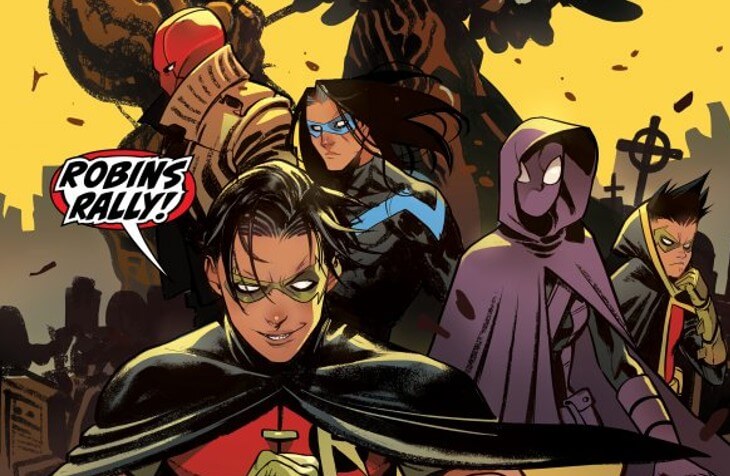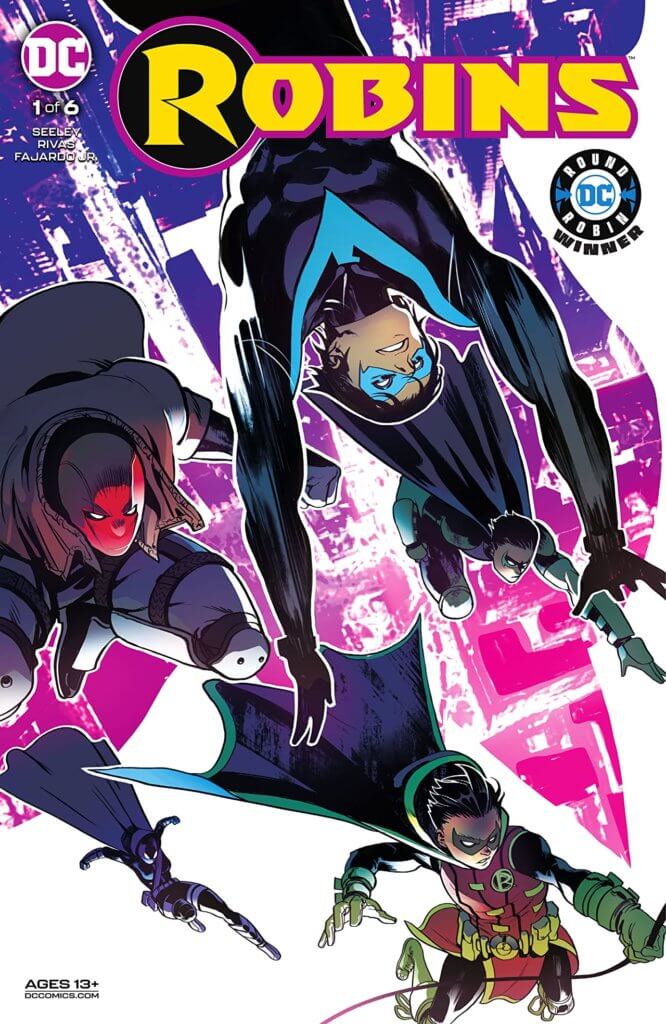Even before hitting stands, Robins had already won. According to CBR, back in March, DC Comics held a contest where fans could vote for the book concept they wanted to see in print as a miniseries. By the end, Robins, a team-up comic between all five of Batman’s canonical Robins, won out against 15 other possible titles. Tim Seeley, no stranger to the Batfamily, pens the book while Baldemar Rivas accompanies on art.
Robins #1 and #2
Romulo Fajardo Jr. (Colorist), Baldemar Rivas (Artist), Tim Seeley (Writer), Steve Wands (Letterer)
DC Comics
November 16, 2021 and December 21, 2021
After opening with the introduction of a mysterious young woman, Robins #1 shifts to the Batkids’ fight against the Devotees of Anarky, a conspiracy theorist cult. Dick Grayson has called the others to Bludhaven to deal with the issue, and once they sort things out with the cultists, the kids have time to sit down and start a heart-to-heart over breakfast about what they all have in common.
I admit that I’m back to DC after a hiatus, so although I can’t place this perfectly into the context of every Robin’s current story, I can speak to how this comic operates as a stand-alone for folks who aren’t pulling every Batfamily title off the shelves. Readers unfamiliar with the Robins will miss a few details, but the issue packs a surprising amount of catch-up information. If you don’t know the individual Robins at all, you’ll hear in their own words how and why they came to the mantle and, in the case of four of them, left it behind. Their conversation at the dinner table during #1 also serves as a thesis statement for what it means to be the boy-or-girl wonder. Dick describes Robin’s role in the Batfamily as “the light in the darkness that brings Batman back before he goes too far.” These tidbits of philosophy run through the first issue in particular and may bog down the book for readers seeking action or elevate it for fans who enjoy self-reflection.
The issue also touches upon a major concern with Robin as a concept–whoever takes the mantle is always a child, always a person who is not emotionally mature enough to crime-fight with such high stakes. Although the issue does not fully unpack it in a way that stalls the story, it does a good job of showing the older Robins reflecting on the naivety of their aspirations and even a sneaking sense of regret.
Although the Robins may think they’re enjoying a private conversation together, they’re not alone. The mysterious young woman from the issue’s cold open has sent a literal Robin who can eavesdrop on their conversation. By the end of the book, she claims to be the very first Robin, usurping Grayson for the title. Her introduction sets her up as the main antagonist and mystery of the miniseries.
The art in issue #1 isn’t as enjoyable as the character-building and plot establishment. There are lots of stringy lines, especially for hair, which often come in distracting, trendy cuts. At worst, a lot of the characters look tired, which could make sense because they spent a hard night fighting Anarky members, but it feels unfinished overall.
Robins #2 expands a connected mystery: why are the culprits from the Robins’ first cases of their respective career popping up again? Bruce referred to each of these initial adversaries as the Robins’ “gauntlets” they had to defeat to pass their initiation test. Issue #2 dives into a database that reveals each case and criminal to help further this story. This inclusion also provides further development for each Robin, as Bruce’s notes on the cases comment on each child’s personality and approach to their job. These mini-episodes are rendered in sepia tones that help distinguish them from the main storyline and offer a lovely vintage feel.
Unlike the first issue, which featured a team-up opening, slower middle, and more intense plot toward the end, issue #2 layers the plot on thick. There’s a lot to follow, and it’s more complicated than it needs to be. It introduces more characters and ends with a shocking image that will make engaged readers wish they could jump straight to Robins #3. Hopefully future issues can pull these new elements together in a more satisfying way.
With that said, the art has significantly improved, feeling less sketchy and much smoother and more fluid. Faces have better shapes, and the action is somewhat easier to follow.
Because the book does well in overviewing the basics of the characters, this series could appeal to fans of TV shows like Teen Titans, Young Justice, and Titans that may not be avid comics readers. In fact, this feels like a good introduction to DC books with characters well-known in DC media. Robins will still appeal to long-time comics fans looking to see their favorite Robin team up with the rest. Overall, these first two issues, despite some unwieldy plot mechanics, promise a solid 6-part miniseries.



